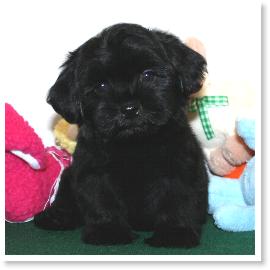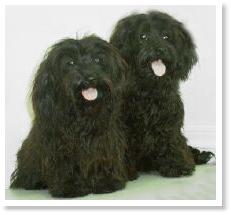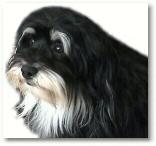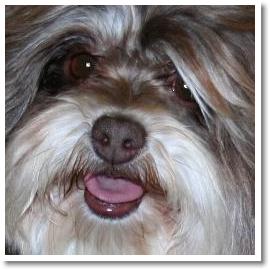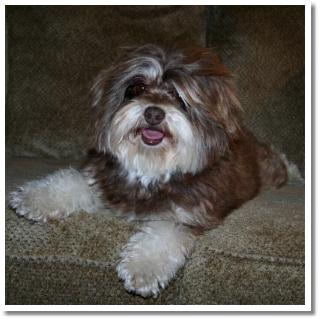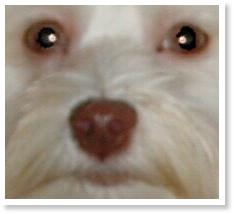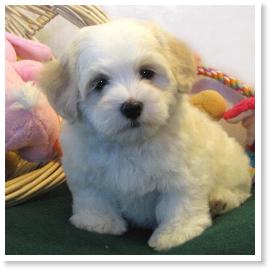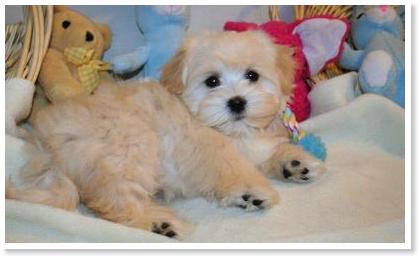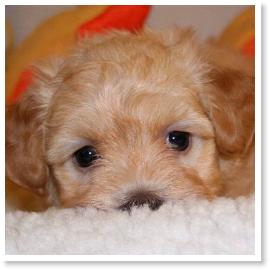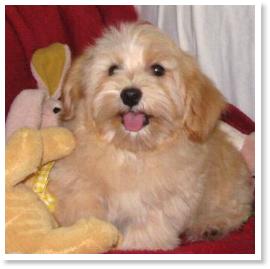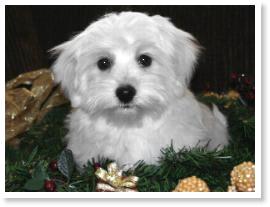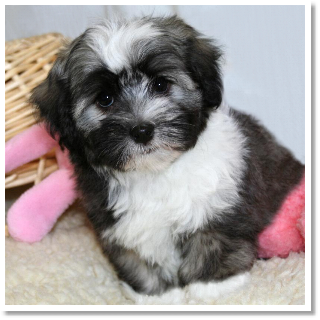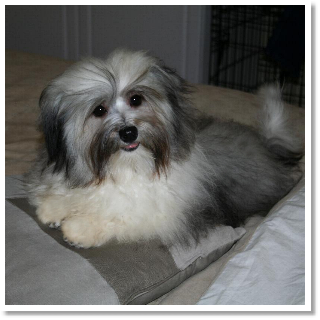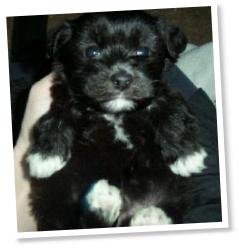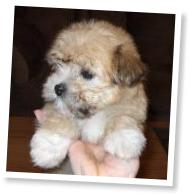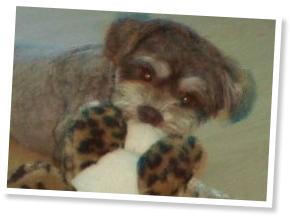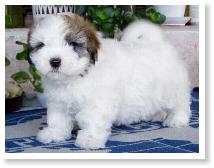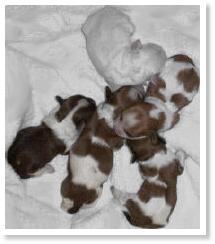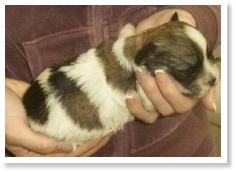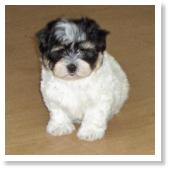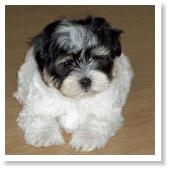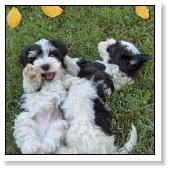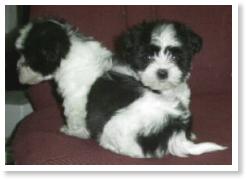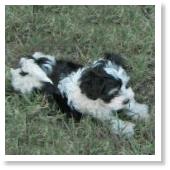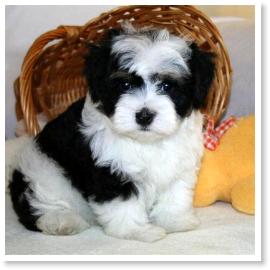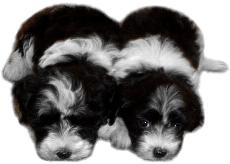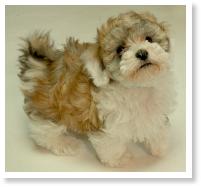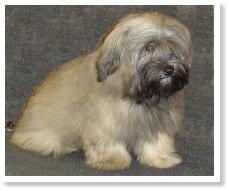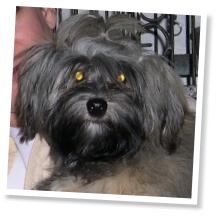The Fun Of Havanese
Colors |
||||||||||||||||||||||||||||||||||||||||||||||||||||||||||||||||
More |
We are often asked about the wide array of colors in the Havanese. They are both intriguing and fun to explore, ever changing as they grow. Predicting these colors takes a little bit of genetic understanding, and a lot of guess work too. We hope you will find the following information helpful in understanding the colors of this amazing breed.HAVANESE COLORS - According to the American Kennel Club's standard, all colors are acceptable, singly or in any combination. There is no preference given to one color over another. We have listed below the standard color options found with AKC registrations and the alternate color options that AKC will allow. Alternate colors do not appear on Dog Registration Applications, but may be hand written on the form along with the corresponding three digit numerical color code. Some of the AKC color options have changed over the years, so colors that may appear on older pedigrees may no longer be available as options today. BLACK [007] - A solid colored dark black, with a glossy appearance, and without reddish or brown tones. This color does not lighten.
BLACK & SILVER [016] or BLACK & TAN [018] - A primarily black coat, with points of tan or silver laid out in the type of pattern that would appear on a Doberman or Rottweiler. These colored points are found on the eyebrows, muzzle, underside of the ears, cheeks, legs, chest and vent. As alternate registration options, Black & Silver or Black & Tan may also appear as the base color of a BRINDLE colored coat (BRINDLE description below), and would then be called BLACK & SILVER BRINDLE [488] or BLACK & TAN BRINDLE [487].
BLUE [037] - Puppies are born black. The black is dull rather than glossy like a true black and may have a dark reddish cast. The coat may start turning as early as 6-8 months or as late as 3-5 years. Once it starts turning, the coat color will continue to develop until it takes on a definite steel blue cast. The in between color is often a muddy brown or reddish color. The final Blue color may be any shade from medium to dark silver/grey/blue and charcoal. Blue may also appear as the base color of a BRINDLE colored coat (see BRINDLE description below), and would then be called BLUE BRINDLE [056]. CHOCOLATE [071]- Puppies are born chocolate. True chocolate dogs will have self colored pigment; they cannot have anything black. They usually also have lighter colored eyes in warm brown, amber or golden shades. Chocolate coats may vary from very light Cafe au Lait to Milk Chocolate to a darker Chocolate color. Some chocolate dogs may turn silver. These would correctly be called a "Chocolate Silver", although AKC does not have this listed as an option. Chocolate refers to the pigment color and not only the coat color. Eye color is the most reliable indicator of whether a dog is actually chocolate or if it just has poor pigmentation. On a true chocolate, in addition to the liver pigment, the eye color will be a soft amber color. If your dogs eyes are black with a lighter brownish nose then what you have is poor pigmentation and not a chocolate.
CREAM [076] - Ivory or creamy yellowish white, the color of dairy cream or almonds. Pale tawny yellow, the color of champagne. Yellow undertones. Cream coats can be beige from light to deep intensity, often with a slightly darker coloring on the ears.
FAWN [082] - Fawn is a cool color ranging from tan and buff to light brown shades. GOLD [091] - This is a rich warm color in various shades of medium gold from honey to apricot. There are very definite reddish highlights to the coat. True Gold dogs retain much of their color throughout their lifetime, though the color may soften with age.
RED [140] - Red is also a rich warm color, similar to Gold with
deeper and more intense color, ranging from to Orangey Red to deep
Mahogany.
SILVER [176] - Puppies are born black and start to lighten at about 4-6 weeks of age. As the dog matures, the coat will lighten to varying shades of silver from pale platinum, sterling and pewter to deep grey. The coat change is complete at approximately 12-15 months of age. WHITE [199]- Pure snow white, with no color allowed on any part of the coat including the ears.
SABLES: GOLD SABLE [486] or RED SABLE [155] - Sable coats are distinguished by darker tipping on a lighter colored underfur. The amount of tipping may be very heavy or very light. The underfur can be gold, red, fawn, chocolate or silver. Tipping is generally black but may also be darker shades of brown, gold or silver. Each hair will be variegated from root to tip. Sable coats often lighten or progressively silver as the dog matures. Some Sable dogs lighten dramatically almost all the way to a pale Ivory or Off-white leaving just subtle shadings and highlights of color. A true Sable will always retain the dark tipping on the ears and tail (even if its just a few hairs). Sable is the most changeable of all the Havanese colors. The degree of silvering is dependent on the other colors in the genetic makeup of the dog. If the tipping is cut off, generally it will not return except perhaps on the ears and tail. The alternate Sable colors are FAWN SABLE [338] , CHOCOLATE SABLE [350] or SILVER SABLE [286]. BRINDLES: BLACK BRINDLE [279] , BLUE BRINDLE [056] , GOLD BRINDLE [485] , RED BRINDLE [148] , SILVER BRINDLE [303] - Much confusion surrounds brindle markings. Brindle is one of the more complex coat colors. The classic brindle combination gives dark bands, more or less regular tiger striped on a lighter background any shade from cream, champagne, tan, gold or silver. (ie. Similar to brindle coats of the Boxer or Dane). Tiger stripes are apparent at birth and run all over the body in streaks or stripes of black or brown. Not all Brindles have this classic striped look. Brindle may also appear more subtly as a combination coat where two or more different color hairs are mixed throughout. Black, brown and auburn hairs intermixed may make a dog appear a tobacco color all over. This combination is often called Havana Brown. In Brindle coats, the color of each hair must go from root to tip. The base color may lighten as the dog matures but the overall pattern will remain. Brindle dogs often have a dark mask on the face. Brindle is not the same as Sable where the coat is only tipped in color. The alternate Brindle color options are BLACK & SILVER BRINDLE [488], BLACK & TAN BRINDLE [487], CHOCOLATE BRINDLE [342] , FAWN BRINDLE [088].
HAVANESE MARKINGS - Defined by the AKC as a "contrasting color or pattern in a dog's coat", markings are found in both irregular placement or specific patterns and may be a variety of colors. The following is a list of the marking options found as registration options. WHITE MARKINGS [014]- On a predominantly solid colored coat, small patches of white trim, often found on the chin, chest and feet are referred to as markings. These markings may also be CREAM [044] or SILVER [034].
TAN POINTS [029] or SILVER POINTS [135] - On a predominantly dark coat of any color, points are distinguished by their pattern on the eyebrows, muzzle, underside of the ears, cheeks, legs, chest and vent. These points may be seen with or without white trim. Although the most common base coat color is black, points are also found often on Sable, Blue, Silver or Chocolate coats. The classic Black coat with Tan Points, without any white trim at all, is known as the Black & Tan. Points may be any shade of tan or gold (Tan Points) and silvered pearl or creamy white (Silver Points). Points that start out in shades of tan often lighten to shades of silver as the dog matures.
PARTI-COLORED (also referred to as PIEBALD) [038] - A two color coat with 50% or more of the coat being white, with the colors laid out in NO particular pattern. There are often irregular patches or spots of any second color. Lightly marked dogs with less than 10% color are called extreme Parti or extreme Piebald. An example might be a white dog with one or both ears partly colored and no colored patches on the body.
The sweet little Black, Parti-colored boys and girls below are all babies of Pekoe and Newman.
IRISH PIED (also referred to as just PIED) [075] - A two color coat with 50% or more of the coat being any color other than white, with the colors laid out in the following SPECIFIC pattern: The underbelly and lower legs are white. There is also white on the chest up to the bottom of the chin, as well as a full or partial white collar or shawl around the neck. The tip of the tail is always white. There may be a colored mask on the face. The coloring on the back is solid and appears as a large saddle or cape covering the shoulders, back and sides. Topline is colored while the underline is always white.
VARIANT GENES - Havanese may carry unexpected genes that will affect the developing color of their coats. These genes contribute to the great mystery and fun of anticipating the changes to come. TICKING GENE - A parti colored dog with this gene will have flecks of color throughout the white coat, giving it a salt and pepper appearance. Dogs without this gene will have a white that stays crisp and pure. SILVERING GENE - The majority of Havanese carry this gene to some degree. This gene is responsible for colors that progressively silver and lighten as the dog matures, much like prematurely greying hair in humans. In the Havanese, this premature greying may start soon after birth. Some color changes can be quite dramatic going from a very dark puppy coat to a pale cream or champagne adult coat.
CHINCHILLA GENE - This gene masks the color red and does not allow it to fully develop. This is most noticeable on Tan Point dogs and is responsible for the points appearing silver rather than tan. This causes some confusion as a number of Tan Point dogs (as adults) have no visible tan on them at all! Depending on the intensity of the gene, the points can be as dark as pewter or as light as pale platinum. Tan Points may lighten and then darken again with maturity. Note: Common points of confusion Many people get confused about the Parti and Pieds - Genetically they are the same but one simply has a greater degree of color. Both are a two color coat but there is a difference in the coat marking patterns. Parti means irregular spots. Pied markings follow a distinct pattern where the top line is one color while the underline must be white and the dog has solid colored mantle covering its shoulders, back and sides. Parti is 50% or more white. Pied is 50% or more colored. The best time to determine the difference is on a young puppy where the color pattern is easily visible before the long adult coat grows in and obscures the lines of definition. Silver vs Blue. As adults some of these dogs may have very similar coloring, though generally Silver dogs are the lighter silver/grey shades while Blue dogs are the darker charcoal/blue shades. You would need to know when the coat change occurred to accurately determine whether it is a true silver or a blue. The big difference between the blue color and the true silver is that true silver dogs start turning silver at the roots at a very early age (4-6 weeks). They first show signs of silvering around the mouth and eyes and may take up to a year of age to become completely silver. Blue dogs remain black at least up to 6-8 months or longer and then start turning towards the silvery blue color later in life. Dogs that are Havana Brown can be mistaken for chocolate as the overall appearance may be similar as adults. The easiest way to tell the difference is to look at the pigment and eyes. Chocolate puppies are born chocolate, and must have liver pigment on the nose, lips and eye rims. They may also have lighter brown or golden eyes. Havana Brown puppies are born black, or so dark brown as to appear almost black. They gradually change to various shades of tobacco brown as the dog matures. Their coats are a combination of black, brown and auburn hairs intermixed. Pigment must be black. When selecting a color for an American Kennel Club registration, keep in mind that they would like puppies to be listed with the color of the anticipated adult coat. Since most puppies are registered at a young age, it may be difficult to select the most fitting color. Many colors lighten in the first few years, and may darken again later or be affected by an unexpected gene. With this in mind, one can only make the most educated guess possible, and remember that although the colors listed on AKC pedigrees may not reflect the most accurate color description, consider it one of the fascinating qualities of this wonderful breed. |
|||||||||||||||||||||||||||||||||||||||||||||||||||||||||||||||
[Home]
[About
Us]
[FAQ'S]
[Contact
Us]
|
||||||||||||||||||||||||||||||||||||||||||||||||||||||||||||||||



